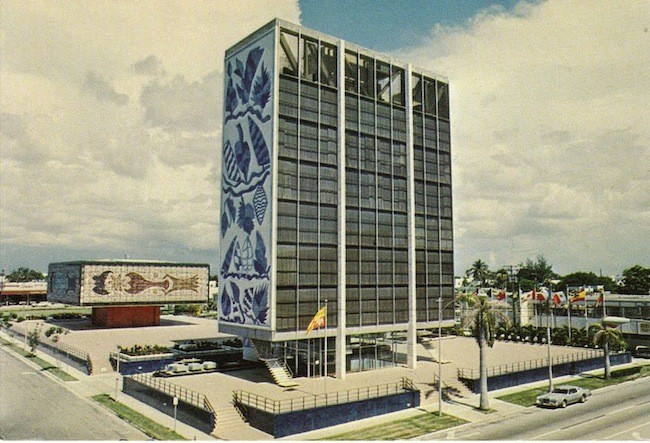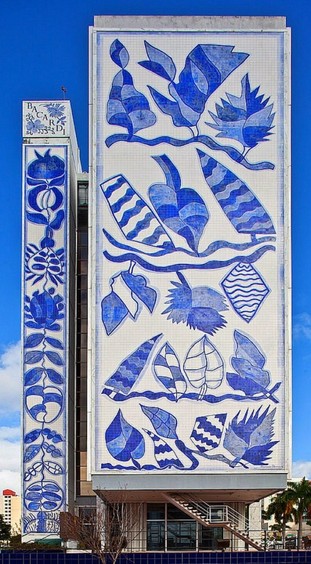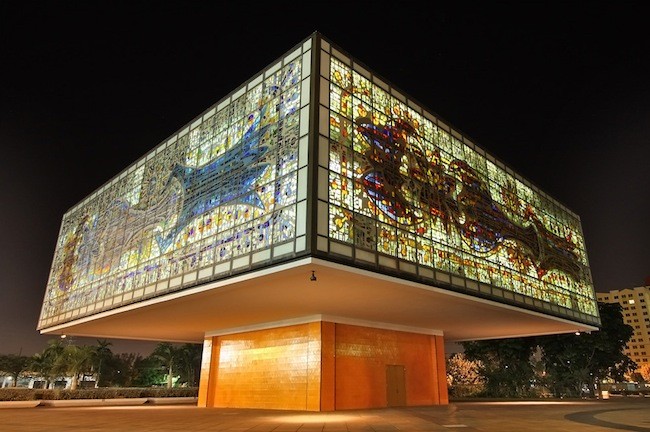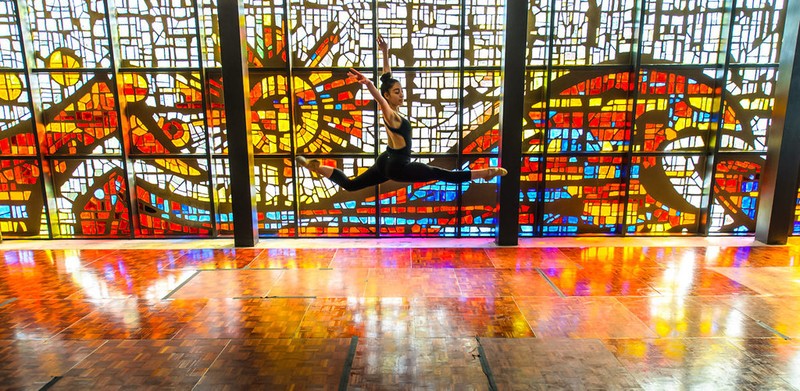YoungArts Campus (Bacardi Complex)
Introduction
Text-to-speech Audio
Images
Historic photo of the Bacardi Complex.

One side of the Bacardi Tower's azulejo mural which includes 28,000 tiles.

The Jewel Box (Annex) lit up at night.

A dancer performs in the Jewel Box.

Backstory and Context
Text-to-speech Audio
Founded in 1862 in Cuba, the Bacardi Corporation enjoyed many decades of success in its native country, before expanding to the United States (US) in 1915. Despite Prohibition creating major setbacks for the company, Bacardi weathered the storm and continued expanding in the US following Prohibition’s repeal. In 1959, the director of the company, Jose “Pepin” Bosch, realized that Fidel Castro’s burgeoning movement in Cuba spelled disaster for private corporations. Bosch began secretly making plans to move the bulk of Bacardi’s manufacturing and processing to the US before he and his family fled in 1960. Bosch chose Miami as the center of Bacardi’s US operations due to Miami’s position as “The Gateway of the Americas.” The Bacardi Corporation rebranded as a broadly Latin American company with a special interest in the plight of Cuban Exiles and Cuban Nationals who remained subject to Castro’s regime. With both commercial and political interests in mind, Bosch began creating a new Bacardi headquarters in the early 1960s.
Bosch initially contacted Bauhaus architectural icon Ludwig Mies van der Rohe to request designs for a new building. Bosch was an ardent appreciator of modernist architecture. The Bacardi president and Mies had previously worked together on Bacardi buildings in Mexico. Furthermore, given Mies’ personal experience and opposition to Nazi despotism, there was a natural ideological match between the two men as well. Mies enthusiastically accepted the commission, though due to logistical and communication disconnects, the architect’s vision for the new building was not able to be executed. Instead, architectural plans were created by Enrique Gutierrez. Gutierrez was a Cuban architect who had collaborated with Mies in the past. He delivered on all three of Bosch’s requirements for the building. These were that the building be tall to attract attention, be open concept so that all employees could see each other, and that the building have ample space for fifty employees.
Gutierrez’s final design for a seven-story tower was rooted firmly in the International Style of architecture. This can be seen in the simple faces, repeated geometry, and focus on structural innovation. Gutierrez designed a system where a glass pedestal on the first floor makes it appear that the building is floating. However, the pedestal supports none of the building’s weight. The architect cleverly hid loadbearing columns and supports throughout the Tower. The east and west sides of the building are composed of floor to ceiling glass panels which allow sunlight to flood the interior space. The north and south walls are cast concrete covered in painted tiles which collectively form an azulejo mural. Bosch hired Brazilian artist Francisco Brennand to design the mural, which depicts stylized tropical plants and animals rendered in blue and white. Brennand created and hand numbered 28,000 tiles in Brazil before shipping them to Miami, where they were unboxed and assembled to form the finished image. Though Bosch wanted the Tower to be complete for Bacardi Corporation’s one hundredth birthday in 1962, construction did not finish until the following year. The Tower housed a small museum of Bacardi Corporation history, a plethora of offices, and a penthouse dining room and corporate bar.
As the Bacardi Corporation continued to expand, it outgrew the Tower space. Miami based Cuban architect Ignacio Carrera-Justiz was commissioned to create a new building that matched the Tower in general aesthetic design principles. The architect’s plans for the Annex were executed on an adjacent lot from 1973 to 1975. The Annex consists of a forty-seven-foot high central square pedestal upon which the main floors of the building rest. The two stories of main floors are cantilevered from the pedestal by twenty-four feet in every direction. The design was a bold choice architecturally, but also practically. Miami frequently experiences hurricane force winds, which would discourage most architects from the design challenges posed by a completely cantilevered structure. However, the elevated main floors of the Annex are not even its most striking feature. The entirety of the building’s walls is composed of stained-glass windows designed by German artist Johannes Dietz. The windows are abstracted but weave a narrative of the history of rum-making. They glass was manufactured in Chartres, France by Gabriel and Jacques Loire. Due to the Annex’s elevated profile and resplendent walls, it was dubbed the Jewel Box by Miami residents.
The Bacardi Corporation continued to use both the Tower and Annex until 2009, when the company moved to a new location in Coral Gables. After Bacardi vacated the buildings, concerned Miami citizens began a campaign to have the buildings designated as historic. The city of Miami acted quickly to protect the structures and granted the requested historic status. In 2018, this work culminated in the buildings being added to the National Register of Historic Places – despite the fact that they were several years short of the minimum fifty years of age required. The buildings were sold to National YoungArts Foundation in 2012. The non-profit arts advocacy organization purchased the complex for $10 million; well below market value. YoungArts contracted renowned artist Frank Gehry to alter the interior spaces of the buildings, though the exteriors were left completely untouched. The first two floors of the Tower were made into an exhibition space and gallery while the rest of the building continues to serve as offices. The Annex was re-envisioned as a space for artists to create. It now includes art workshops, music rooms, and dance studios. Thanks to the efforts of Miami citizens and YoungArts, the Bacardi buildings continue to stand as iconic landmarks in the city.
Sources
About, National YoungArts Foundation. Accessed November 11th 2020. https://www.youngarts.org/about.
Architecture | Flashback 2009: Bacardi Building in Miami Gains Historic Status, Cfile. June 9th 2014. Accessed November 11th 2020. https://cfileonline.org/architecture-flashback-2009-bacardi-building-miami-gains-historic-status/.
Bacardi Building, Flashback Miami. Accessed November 11th 2020. https://flashbackmiami.com/2014/12/03/bacardi-building/.
The Bacardi Buildings, City of Miami. October 6th 2009. Accessed November 11th 2020. http://egov.ci.miami.fl.us/Legistarweb/Attachments/60081.pdf.
Bacardi Tower Building, Emporis. Accessed November 11th 2020. https://www.emporis.com/buildings/122298/bacardi-tower-building-miami-fl-usa.
Cohen, Travis. Miami Icons: The Bacardi Complex (AKA YoungArts), Striking Beauty of Biscayne, Miami New Times. August 6th 2014. Accessed November 11th 2020. https://www.miaminewtimes.com/arts/miami-icons-the-bacardi-complex-aka-youngarts-striking-beauty-of-biscayne-6514946.
Fuentes, Gabriel. Frank Gehry to Masterplan Miami’s Landmark Bacardi Complex, The Architect's Newspaper. October 8th 2012. Accessed November 11th 2020. https://www.archpaper.com/2012/10/frank-gehry-to-masterplan-miamis-landmark-bacardi-complex/.
Hegedus-Garcia, Ines. Miami Architecture - The Bacardi Complex aka YoungArts, Miamism. September 11th 2018. Accessed November 11th 2020. https://www.miamism.com/blog/miami-architecture-bacardi-complex-aka-youngarts.
Iconic Bacardi Building Sold in Miami, Caribbean Journal. October 3rd 2012. Accessed November 11th 2020. https://www.caribjournal.com/2012/10/03/iconic-bacardi-building-in-miami-sold/.
Iconic Bacardi Complex In Miami To Become Headquarters For National YoungArts Foundation, Cision. October 3rd 2012. Accessed November 11th 2020. https://www.prnewswire.com/news-releases/iconic-bacardi-complex-in-miami-to-become-headquarters-for-national-youngarts-foundation-172570841.html.
Lush, Tamara. Miami weighs preserving iconic Bacardi buildings, The San Diego Union-Tribune. May 7th 2009. Accessed November 11th 2020. https://www.sandiegouniontribune.com/sdut-bacardi-buildings-040709-2009apr07-story.html.
National Headquarters, National YoungArts Foundation. Accessed November 11th 2020. https://www.youngarts.org/national-headquarters.
Rubensteen, Aimee. Miami's Jewel Box, theartsection. Accessed November 11th 2020. https://www.theartsection.com/jewel-box.
Cfile. Accessed November 11, 2020. https://cfileonline.org/architecture-flashback-2009-bacardi-building-miami-gains-historic-status/.
Cfile. Accessed November 11, 2020. https://cfileonline.org/architecture-flashback-2009-bacardi-building-miami-gains-historic-status/.
Cfile. Accessed November 11, 2020. https://cfileonline.org/architecture-flashback-2009-bacardi-building-miami-gains-historic-status/.
Zazzle. Accessed November 11, 2020. https://blog.zazzle.com/2014/06/22/special-guest-interview-national-youngarts-foundation/.
